Special
Exhibits:
Shay
Steam Locomotive (Serial #1643)
Shay locomotive, serial number 1643,
fondly known as “Ole
Four Spot”, is on display in front of the Heritage Museum,
next to US Highway 2, and is one of our most prized exhibits. She
served as a workhorse for the Libby Lumber Co and later the J.
Neils Lumber Co. for logging operations in and around Libby, Montana
in the early 1900s.
This is a powerful standard gauge, Class B 37-2, gear driven Shay locomotive,
commonly referred to as a sidewinder or a stem-winder because of
the peculiar arrangement of gears and a drive shaft running the full-length of
the right side of the locomotive making all wheels drivers. It was manufactured
by the Lima Locomotive Works in 1906 at Lima, Ohio as one in a special class
of four locomotives (serial numbers 1642, 1643, 1644 and 1645) built for the
Thompson Greer Construction Company. All have the same builder date of March
7th, 1906 and all were shipped to Buhl, Minnesota. Locomotive No.
1643 was designated Thompson Greer Engine No. 11. and is the only survivor of
their class, all others having been scrapped.
It is believed she may have been leased to the Rainy Creek Lumber Company for
logging operations near the Minnesota--Canadian border for a time, but it is
known that she was delivered to Buhl by common carrier and hauled across a frozen
lake on a logging sleigh to the company logging railroad. There she hauled logs
from the forest to water until 1909 when purchased by the Libby Lumber Company
of Libby, Montana and shipped there by rail. The Libby Lumber Co. designated
her Libby Lumber Engine No 4 and she has retained road number 4 through all subsequent
ownerships.
At Libby, she hauled logs, supplies and logging crews until about 1924 over rough,
uneven, steep logging lines east of Libby with an efficient operating range of
only about 15 miles due to an operating speed of about 12 miles per hour. Later,
rails were laid some 12 miles to the west, over J. Neils’ RR logging bridge
across the Kootenai River to access valuable forest reserves owned or operated
by the company. The abandoned J. Neils RR logging bridge was destroyed by US
Army sappers during WWII as a training exercise.
Between 1925 and 1931, she operated on the Great Northern mainline north of Libby
along the Kootenai River for a distance of about 12 miles and after 1931 was
used primarily to haul logging crews and equipment to logging camps and to perform
switching operations in the woods.
After 1936, railroad logging gave way to logging by trucks. The "Ole Four Spot" was
used primarily for switching cars in the mill yard and to the local Great Northern
mainline, a distance of about 1/2 mile. This use continued until about 1944,
when she was replaced by a larger locomotive, J. Neils No. 5, brought here from
Klickitat, Washington. However, she continued intermittent switching until
retired from operations in about 1946, for an active service life of about 39
years. Ole Four Spot was then left to molder in the mill bone yard until
about 1963 when the new mill owners, The St. Regis Lumber Co., decided to give
her a cosmetic face list and put her on permanent display outside their Libby
offices. There she remained until acquired by The Heritage Museum. She was moved
by truck to the new museum grounds not a half mile from her former place of labor
as a switch engine at the end of the line and but a few hundred feet of the site
of her days in the bone yard.
In the mid 1980’s Ole Four Spot, in need of preservation, received a further
cosmetic treatment by museum volunteers to keep her on display a few more years
until restoration might return her to glory with the ultimate goal of returning
her to active service as Engine No 4 on the recently established J. Neils and
Heritage Museum Logging Railway.
Shay Locomotives were built from 1878 until 1945 in many sizes configurations
and gauges. These steam locomotives were used coast to coast and the world over
with 3,354 locomotives manufactured by the company in the Shay pattern. The shay
has a very distinct frontal profile. Because of the great weight of the (2 or
3) vertical steam engines on the right side of the locomotive and the geared
drive shaft arrangement, the boiler is off set to the opposite side to balance
the weight of these two major components. From the front shays appear to have
been in an accident that shifted the boiler to one side.
Shays were fueled variously by wood, coal, oil and gas with even experimentally
configured diesel engine driven shays. Although few of these were actually manufactured
by Lima and none are known to survive as originally configured shay designed
diesel locomotives, rumors abound of after market conversions.
Builder Specifications for locomotive no. 1643
Original empty shipping weight: 64,900 pounds
Weight with full load of fuel and water: 42 tons
42" Wagon top boiler
Original Working Pressure -180 pounds
Three 10" by 12" vertically oriented cylinders on the right side
Two trucks of four 29.5 inch wheels under each truck
Steam Jam locomotive brakes
Westinghouse air brake to control cars making up a train
Steam dynamo electrical lighting system
Fuel Used by locomotive 1643
Wood in the Minnesota and early Montana operations.
Coal in Montana operations until about 1927.
Converted to Oil probably in 1927.
Speed of a train handled by this locomotive was approximately 12 miles per hour
on good track. Operations on spurs in the woods might involve grades from flat
to over 11%. On the steep grades of up to 11%, this locomotive was designed to
push two empty steel logging cars uphill at a speed of about 6 miles per hour. Coal
consumption for an average day's work was approximately 2 tons which had to be
shoveled into the firebox by a fireman. About every 3 hours, the locomotive would
take on water by siphoning from a nearby stream on logging spurs or from a water
tank located on the mainline or at the mill. Ole Four Spot carried 2000 gallons
of water in her tank. Water from creeks and streams were plentiful and only rarely
were additional water tenders added to Montana logging trains.
The National Railway Historical Society gives $5000 Grant for Shay 1643
The
Heritage Museum received a $5000.00 grant from the National Railway Historical
Society to begin preservation of the Shay. The money
was used to plan and begin a multi-year project to stabilize, preserve and protect
the engine until full restoration could be undertaken. This grant allowed the
Heritage Museum to begin efforts to save the remaining native logging engine
in Northwest Montana.
Please help us restore the Shay!
Are you a railroad enthusiast or RR history
buff who would like to help our efforts to restore Ole Four Spot? We welcome
volunteers and donations of money, experience, materials, advice, and bequests
towards returning her to active service at the museum. We are a non-profit, 501
(c) (3) organization. Accordingly, donations are generally tax deductible. Your
kind donations will help us to continue to preserve, protect and restore our
beloved shay. For more information about volunteering or donating toward restoration
of the Shay Locomotive, click here and tell us how
you may be able to help.
Related Links:
Home |
Exhibits | About Us | Links | Contact Us |
|
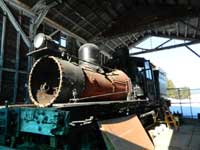
Above:
Shay basking in the sun fireman's side. Photo courtesy Heritage
Museum.
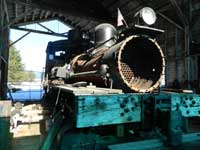
Looking back down the boiler to the engineer's station. Photo courtesy
Heritage Museum.
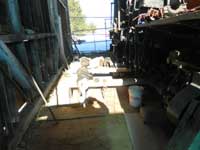
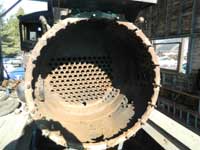
Looking into the smokebox at firetubes. Photo courtesy Heritage
Museum.
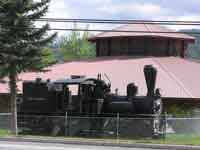
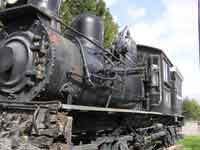
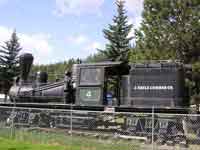
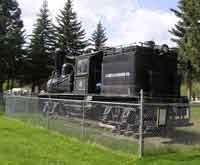
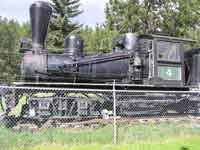
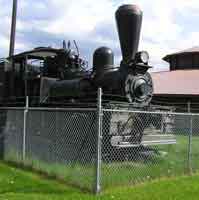
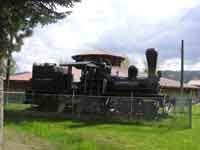

|
|
